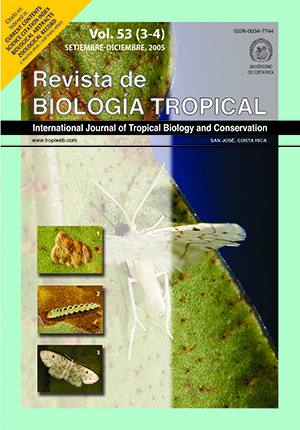Abstract
The diversity, composition and structure of vegetation in a cattle landscape in Matiguás, Nicaragua was characterized, and the floristic and structural differences of six types of habitats (secondary forests, riparian forests, charrales, live fences and pastures with high and low tree cover) were compared. A total of 3 949 trees of 180 species and 52 families were recorded. Forty six percent of the total trees reported for the landscape were represented by Guazuma ulmifolia (18.5%), Bursera simaruba (13.2%), Tabebuia rosea (6.3%), Enterolobium cyclocarpum (4.2%) and Albizia saman (3.4%). Many of the dominant species in the landscape were typical of open and disturbed areas. There were significant differences between the different habitats in the patterns of tree species richness, abundance, diversity, structure and floristic composition. The riparian forests had greater tree richness (p=0.0001) and diversity (p=0.0009) than other habitats. The floristic composition varied across habitats, with pairs of habitats sharing between 18.4 and 51.6% of the same tree species, and with clear differences in composition between the forested (riparian and secondary forests) and agricultural habitats. Of the habitats studied, the riparian forests and secondary forests seem to have greatest value for the conservation of the flora in the agropaisaje because they have the greatest species richness, and maintain small populations of endangered species. On the basis of the study, we recommend including agricultural landscapes in strategies to conserve tree diversity and suggest measures to ensure the maintenance of tree diversity in the Matiguas landscapeReferences
Esquivel, H., M. Ibrahim, C.A Harvey, C. Villanueva, T. Benjamín & F. Sinclair. 2004. Árboles dispersos en potreros de fincas ganaderas en un ecosistema seco de Costa Rica. RAFA. 10: 24-29.
Gallego, B. 2002. Estructura y composición de un paisaje fragmentado y su relación con especies arbóreas indicadoras en una zona de bosque muy húmedo tropical, de Costa Rica. Tesis de Maestría, CATIE, Turrialba, Costa Rica. 103 p.
Gordon J.E., D. Hawthorne, A. Garcia-Reyes, G. Sandoval & A. Barrance. 2004. Assessing landscapes: a case study of tree and shrub diversity in the seasonally dry tropical forest of Oaxaca, México and Southern Honduras. Biol. Conserv. 117: 429-442.
Gordon J.E., D. Hawthorne, A. Garcia-Reyes, G. Sandoval & A. Barrance. 2003a. Trees and farming in the dry zone of Southern Honduras II: the potential for tree diversity conservation. Agrof. Systems. 59: 107-117.
Gordon J.E., A. Barrance & K. Schreckenberg. 2003b. Are rare species useful species? Obstacles to the conservation
of tree diversity in the dry forest zone agro– ecosystems of Mesoamerica. Glob. Ecol. Biogeogr. 12: 13-19.
Harvey, C.A., C. Villanueva, J. Villacís, M. Chacon, D. Muñoz, M. López, M. Ibrahim, R. Gómez, R. Taylor, J. Martínez, A. Navas, J. Sáenz, D. Sánchez, A. Medina, S. Vilchez, B. Hernández, A. Pérez, F. Ruiz, F. López, I. Lang, S. Kunth & F. Sinclair. 2003. Contribución de las cercas vivas a la productividad e integridad ecológica de los paisajes agrícolas en América Central. RAFA. 10: 30-39.
Harvey, C.A., & W.A. Haber. 1999. Remanent trees and the conservation of biodiversity in Costa Rican pastures. Agrof. Systems. 44: 37-68.
Janzen, D. 1991. Historia natural de Costa Rica. San José, Costa Rica. 822 p.
Kattan, G. 2002. Fragmentación: patrones y mecanismos de extinción de especies, p. 561-590. In M. Guariguata & G. Kattan, (eds.). Ecología y conservación de bosques neotropicales. Cartago, Costa Rica, LUR. Ministerio del Ambiente y Recursos Naturales (MARENA). 2003. Normas y procedimientos para la exportación e importación de especies de flora y fauna silvestre de Nicaragua. Managua, Nicaragua. 17 p.
Martínez, J. 2003. Conocimiento local de productores ganaderos sobre cobertura arbórea en la parte baja de la cuenca del río Bulbul en Matiguas, Nicaragua. Tesis de Maestría, CATIE, Turrialba, Costa Rica. 159 p.
Medina, A., C.A, Harvey, D. Sánchez, S. Vilchez & B. Hernández. 2004. Diversidad y composición de chiropteros en un paisaje fragmentado de bosque seco en Rivas, Nicaragua. Managua, Nicaragua. Encuentros 68: 24-43.
Meyrat, A. 2000. Los ecosistemas y formaciones vegetales de Nicaragua. Protierra / MARENA / CBA. Managua, Nicaragua. 30 p.
Myers, N., R.A. Mittermeier, C.G. Mittermeier, G.A. da Fonseca & J. Kent. 2000. Biodiversity hotspots for conservation priorities. Nature 403: 853-858.
Pérez, M. 2000. Composición y diversidad de los bosques de la región Autónoma Atlántico Norte Nicaragüense: una base para el manejo sostenible. Tesis de Maestría, CATIE, Turrialba, Costa Rica. 155 p.
Pither, R., & M. Kellman. 2002. Tree species in small tropical riparian forest fragments in Belize, Central America. Biodivers. Conserv. 11: 1623-1636.
Pomareda, C. 1999. Situación y perspectiva de la ganadería e industrias afines en Centroamérica. En: taller regional sobre desafíos y oportunidades de la ganadería e industrias afines en Centroamérica. Consejo agropecuario centroamericano / Proyecto RUTA-Banco Mundial. Guatemala, Guatemala. 12 p.
Robledo, C.W., J.A. Di Rienzo, W. Guzmán, M.G. Balzarini, F. Casanovas, L.A. González, & E.M. Tablada. 2000. InfoStat/profesional versión 1.6. Departamento de estadística y biometría y de diseño de experimentos. Facultad de ciencias agropecuarias de la Universidad Nacional de Córdoba (FCA-UNC).
Salas, J. 1993. Árboles de Nicaragua. Servicio Forestal Nacional. HISPAMER. Managua, Nicaragua. 390 p.
Silva-Matos, D.M., G. D.F.M. Fonseca & L. Silva-Lima. 2005. Differences on post-fire regeneration of the pioneer trees Cecropia glazioui and Trema micrantha in a lowland Brazilian Atlantic Forest. Rev. Biol. Trop. 53: 1-4.
Stevens, W. 2001. Introducción de vegetación, p. 1-23. In W. Stevens, C. Ulloa, A. Pool & O. Montiel (eds.). Flora de Nicaragua. Jardín Botánico de Misurí.
Vilchez, S., C.A. Harvey, D. Sánchez, A. Medina & B. Hernández. 2004. Diversidad de aves en un paisaje fragmentado de bosque seco en Rivas, Nicaragua. Managua, Nicaragua. Encuentros. 68: 60-75.
##plugins.facebook.comentarios##

This work is licensed under a Creative Commons Attribution 4.0 International License.
Copyright (c) 2005 Revista de Biología Tropical






